The word jellyfish gives us chills because the ones we know are stingy and poisonous. They are so mind-blowing and glow in the dark. And they obviously live in the sea. But are there jellyfish that live in freshwater bodies? Are freshwater jellyfish poisonous like saltwater jellyfish?
We will clear most of your doubts in this article and tell you how to keep these freshwater jellyfish in your aquarium.
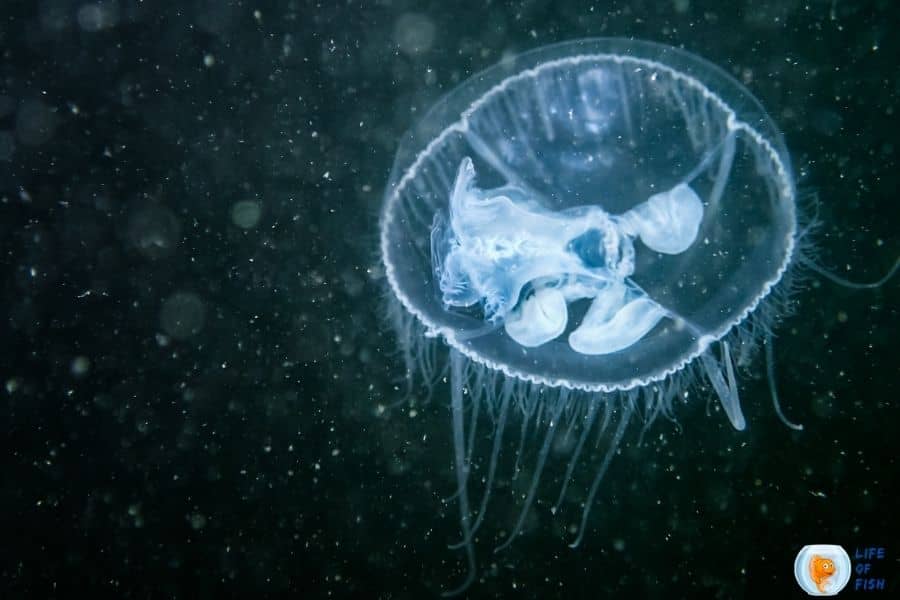
Are there freshwater jellyfish?
Jump To
- 1 Are there freshwater jellyfish?
- 2 One look care guide
- 3 Get to know them
- 4 Can you keep freshwater jellyfish as pets?
- 5 How can you catch freshwater jellyfish?
- 6 Freshwater jellyfish care in aquariums
- 7 The health of the freshwater jellyfish
- 8 What fish can live with freshwater jellyfish in aquariums?
- 9 Can we breed freshwater jellyfish in captivity?
- 10 Freshwater jellyfish predators
- 11 Recently asked questions
Yes. There are one species of jellyfish that lives in freshwater. Craspedacusta sowerbii, also known as peach blossom jellyfish, is a freshwater jellyfish species that live in freshwater lakes, ponds, quarries, reservoirs, streams, and rivers.
They are commonly known as freshwater jellyfish, but many do not know these species. You can find them worldwide as these are considered invasive species.
In North America, they are typically found in late summer during August and September.
In China, they are sighted in September and October. Anyhow, the appearance of these species is sporadic and unpredictable from year to year. Therefore, you may not find them easily.
This jellyfish is a hydrozoan jellyfish or hydromedusa cnidarian, which differs from scyphozoan jellyfish or the true jellyfish found in the ocean. They are also known as hydromedusa.

One look care guide
| Scientific name | Craspedacusta sowerbii |
| Common name | Freshwater Jellyfish |
| Care level | Hard |
| Native to | China |
| Type | Jellyfish |
| Color | Transparent |
| Tank size | 20 gallons |
| Preferred temperature | 68-77 °F |
| Other water parameters (ammonia ,ect) | pH level 6.5 – 7 |
| Preferred salinity | No salinity. Freshwater species. |
| Size of the freshwater jellyfish | 5- 25mm |
| Life Span | Very short. Not known accurately. |
| Temperament | Non-Aggressive invertebrates |
| Recommended tank mates | Large fish No small fish crayfish turtles |
| Preferred food | Small fish fish fry zooplanktons like brine shrimp daphnia copepods |
| Feeding frequency | Once per day |
| Breeding | Very Hard |
Get to know them
Originate in
Peach blossom jellyfish originate from the Yangtze basin in China, but they are now found throughout the world in freshwater bodies as these are invasive species.
However, you may not find them in Antarctica.
Appearance and size
Craspedacusta sowerbyi measures about 5–25 mm in diameter in their medusa (adult) form. It is nearly the size of a penny. It has a translucent bell-shaped body with a whitish or greenish tinge.
Due to their transparent body, even a swarm of C. sowerbii is hard to detect by the naked eye.
How long do freshwater jellyfish live
The lifespan of C. sowerbii has not yet been discovered. However, these jellyfish end their life after they mate, just like ocean jellyfish.
Life Cycle
The life cycle of freshwater jellyfish and ocean jellyfish is quite alike. The first form of life is the zygote. Zygotes are formed by sexual reproduction from sperm and an egg of adult medusa. Then it becomes a planula (larvae).
These planula floats in the water until they find a hard surface (rocks, plant leaves) to attach to. After some time, these planula develop into a polyp.
This polyp can reproduce by asexual reproduction by budding. It buds off ephyra (immature medusa) that eventually grows up into adult medusas.
These adult medusas reproduce by sexual reproduction. They fertilize eggs with sperms, and the whole process starts again. The adult medusa dies after sexual reproduction.
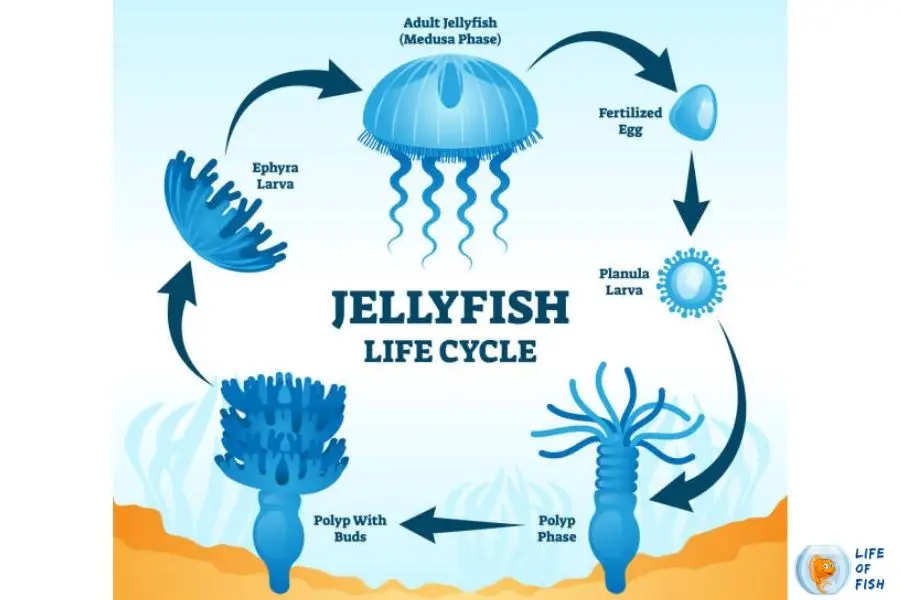
Food preference
C. sowerbii are carnivore jellyfish species. They need meat-based food to survive.
In the wild, they prey on brine shrimp, daphnia, copepods, or other zooplanktons. They catch the prey with their stinging tentacles.
The behavior of freshwater jellyfish
They start their life as polyps living in colonies attached to underwater vegetation or rocks. During their life as polyps, they feed and reproduce asexually.
To find prey, they drift with their tentacles extended. These fish wait until the prey touches a tentacle.
Then the nematocysts on the tentacle immediately fire poison on the prey. This poison paralyzes the animal and the jellyfish coil around the prey with its tentacles.
Then the tentacles bring the prey into the mouth to eat.
During winter, C. sowerbii polyps enter dormancy and become podocytes. Once the conditions get favorable, these podocytes develop into polyps again.
Although it is rare, mature medusas reproduce sexually. But, soon after these jellyfish reproduce, they die.
Are they toxic
Although they have stinging cells like saltwater jellyfish, the poison is effective only for tiny prey.
They are not toxic to humans. However, if you are prone to allergies, these stings may cause skin irritation and itching. But, it will not be fatal.
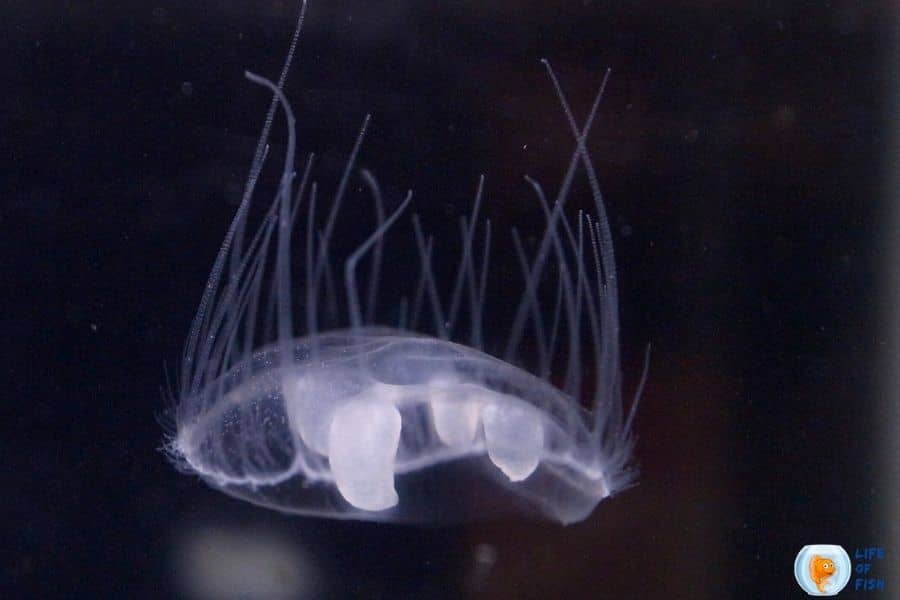
Can you keep freshwater jellyfish as pets?
Yes. You can keep C. sowerbii in an aquarium as pets. However, keeping these jellyfish with fish is not recommended as their sting may harm your fish.
And also, they have particular requirements in order to thrive. Further, their mortality in aquariums is high.
Although these are hardy creatures, keeping freshwater jellyfish in aquariums is relatively difficult.
So, unless you are an experienced aquarist who has experience keeping exotic fish species, do not keep them in your aquarium.
How can you catch freshwater jellyfish?
Do not catch these creatures in bare hands, as C. sowerbii stings can cause irritation or itchiness.
You can use a net to capture these jellyfish. But, we recommend using a plastic container to extract them from the water because by using that method, you can ensure no harm to the jellyfish.
They are very small and fragile creatures that can be harmed by nets.
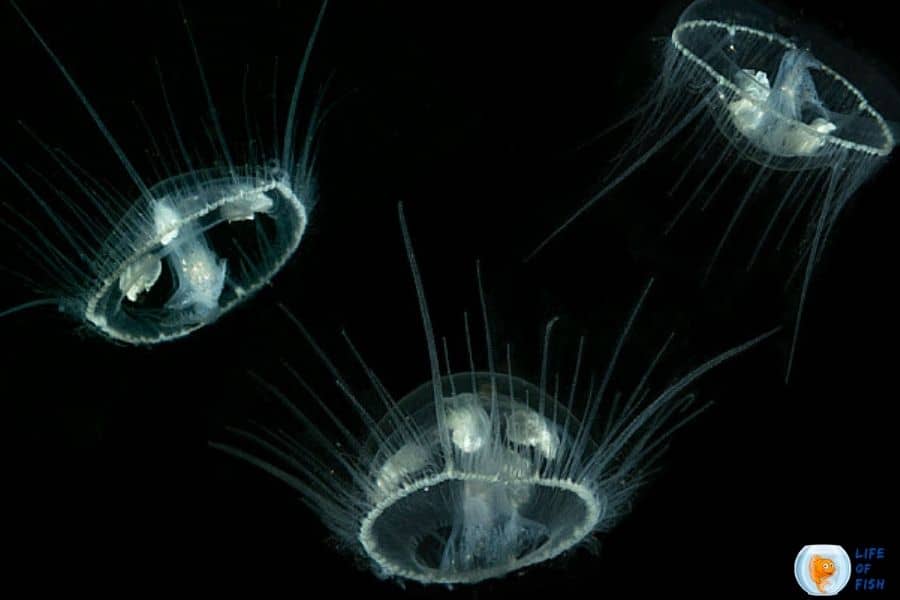
Freshwater jellyfish care in aquariums
If you wish to keep them in your aquarium, you must know things before introducing them to your aquarium.
Freshwater jellyfish tanks
Preferable size
Freshwater jellyfish require at least a 20-gallon tank to thrive. Although these fish are so small, they need more space to explore.
Substrate
Filling the aquarium with a deep substrate is recommended for C. sowerbii . Deep substrates make room for more bacteria and will help decay the waste faster.
Do they need filters and air pump
Yes. Freshwater jellyfish need filters in the aquarium. However, you need to be careful installing a filter as these fish hate strong water flow.
You should choose a water filter that slowly circulates the water. And also, the filter should be covered with a sponge to prevent sucking up of these creatures. Adding an air pump is not recommended.
Lighting
These jellyfish can adapt to any lighting condition. So, change the lighting as per the needs of the plants.
Where to place the tank
Placing the tank in a dark corner of your room and lighting up the tank is recommended as this way, your jellyfish will glow. In strong lights, they may not be visible.
How many freshwater jellyfish should be kept together per gallon?
As polyps, these jellyfish stay in colonies. And also, these creatures measure only about 2 cm maximum.
So, you can keep more than one C. sowerbii in an aquarium. Although there is no specific amount that is tried and true, we recommend keeping about five jellyfish in one aquarium.
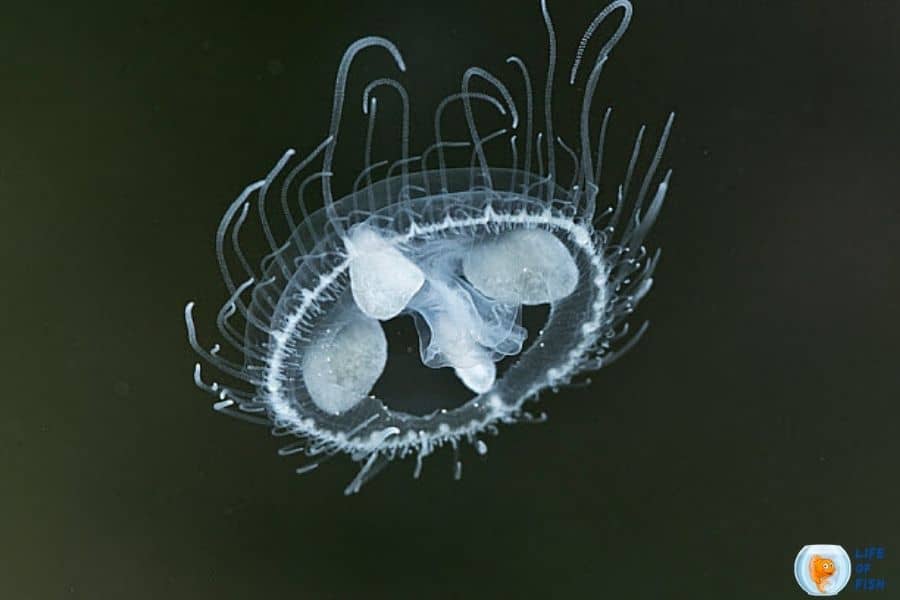
Water quality condition
Since freshwater jellyfish live around the world except for Antarctica, we can assume they are hardy and can tolerate a variety of water conditions.
The particular water conditions may vary according to the area they used to live in (we assume that you catch these jellyfish from a natural water body as they are not available to buy at pet stores).
But, we will cover optimum water conditions for most freshwater fish.
Water
As you plan to keep wildly caught fish species, we recommend not to use tap water as tap water contains chemicals like chlorine that can be harmful to your jellyfish.
Use RO/DI water with remineralizes added according to recommended dosage in the product instructions. Let the tank establish by cycling the tank for about two weeks beforehand.
Temperature
C. sowerbii prefer slightly cold water. The optimum water temperature for these creatures is 68-77 °F.
Salinity
Freshwater jellyfish can only live in freshwater bodies.
Hardness
C. sowerbii have been found in many freshwater bodies around the world. So, we can assume that these fish can bear various water hardness levels.
Ammonia, nitrate nitrate
We recommend keeping Ammonia, Nitrite, and Nitrate levels at level zero as with any other aquarium.
Ph
Freshwater Jellyfish prefer neutral water. So, the pH level should be between 6.5 and 7.
Water changing
As these are tiny species, you may need minimum water changes if you have only a freshwater jellyfish tank. We recommend about 10-15% water changes every two weeks for an aquarium.
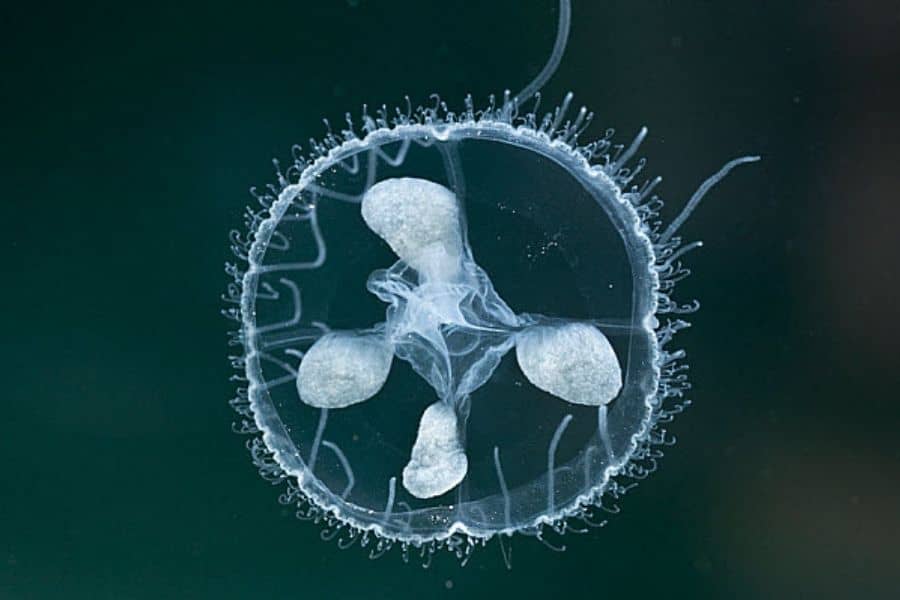
The health of the freshwater jellyfish
Different ways they can get hurt
As these are very small aquatic creatures, they can be prey to crayfish and turtles. And also, they can suck up into the filter.
Even a sponge filter can suck the fish onto the sponge. And also, strong water flow can kill these creatures. So, keeping a slow circulating water filter is essential.
Diseases of freshwater jellyfish
As these jellyfish are short-lived species, the diseases are not yet investigated. However, these jellyfish are hardy species that can survive throughout colder months by forming into podocytes.
What fish can live with freshwater jellyfish in aquariums?
The stings of C. sowerbii can harm or even be deadly to small fish species. Therefore, keeping these species with small fish is not recommended.
We do not recommend keeping them with crayfish and turtles either, as these species can eat jellyfish.
Suitable tankmates are large fish that can tolerate similar water conditions.
Can we breed freshwater jellyfish in captivity?
Since these jellyfish have a highly complex reproduction system and the optimum water conditions for breeding are unknown, breeding them in captivity is extremely difficult.
There are no reports of even one successful breeding of these species in captivity.
Freshwater jellyfish predators
Due to their stinging ability, most fish avoid eating freshwater jellyfish. However, crayfish and turtles prey on these species.

Recently asked questions
Are freshwater jellyfish poisonous?
Freshwater jellyfish are poisonous only to small fish and invertebrates. They use their sting cells to inject toxins and paralyze their prey.
These toxins are poisonous to their prey. They are not poisonous to large fish and humans.
Can freshwater jellyfish sting?
Yes. Freshwater jellyfish can sting. But, these stinging cells can not penetrate the human skin.
Although they can not harm you, it is better not to touch them because these stings can cause skin irritation and itching if you are hypersensitive.
Where are freshwater jellyfish found?
Freshwater jellyfish are found everywhere in the world except for Antarctica.
These jellyfish are native to the Yangtze basin in China but introduced to many water bodies around the world. You can find them in most states in North and South America.
You can also find them in most Canadian provinces except Alberta and Saskatchewan.
These jellyfish are present in the Wang Thong River in Thailand. They were also reported in Panama in 1925, Chile in 1942, Argentina in 1950, Brazil in 1963, and Uruguay in 1971.
There are reports on the presence of these jellyfish even in India, Hungary, and Russia. Freshwater jellyfish usually live in calm, freshwater lakes, impoundments, reservoirs, gravel pits, or quarries.
They can also live in slow-moving backwaters of river systems. However, they can not survive in fast-flowing streams or rivers.
Can jellyfish live forever?
A single freshwater jellyfish can not live forever. In fact, the lifespan of freshwater jellyfish is very short.
But, these species have an insane reproduction ability, both sexual and asexual. Because of these breeding, the number of these species increases at insane levels.
And also, these jellyfish can survive through freezing cold by forming into podocytes.
Further, the jellyfish’s history goes back to at least 500 million years ( more older than the dinosaur age). Therefore, we can say that freshwater jellyfish can live forever.
Read Next: Malawa Shrimp (Caridina pareparensis parvidentata) Care |11 Interesting Facts |
